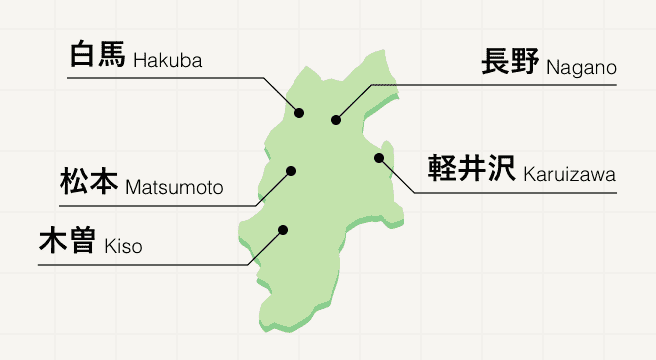Traditional Streets/Houses Spots in Nagano Area
Area
-
-
Nagano
-
-
Nagano

-
-
Traditional Streets/Houses
-
Traditional Streets/Houses
Category


-
- Tsumago-juku
- Travel / Tourism
- Nagano Pref. Kisogunnagisomachi Aduma 2159-2
- One of the Nakasendo (old route from Tokyo to Kyoto) post towns which still retains the appearance of a post town from the Edo period. Tsumago-juku is known as the first post town in Japan to preserve its old town atmosphere and it has been designated as an important architectural preservation site and a regional conservation area. The town is full of places to see such as Koi-iwa (Carp rock), one of the three famous rocks, the Waki-Honjin Okuya (a National Important Cultural Property), Nagiso Museum of History with displays on the history of Nagiso Town and the Kisoji Road, and the preservation of Tsumago-juku.
-
- Magome Pass Village
- Travel / Tourism
- Gifu Nakatsugawa-shi Magome
- The name of a village along the Nakasendo Road connecting Tsumago and Magome inns, located on the Magome side of Magome Pass at an elevation of 790 m. Until the Edo period, many people who lived in the village used oxen to transport goods, and the village was crowded with people called "Ushikata" (cattlemen). Even today, about 20 houses still stand side by side, and many people stop by on their way to hike over Magome Pass.
-
- Kisohirasawa
- Travel / Tourism
- Nagano Shiojiri-shi Kisohirasawa
- This town, located in the center of Nagano Prefecture, developed on the large curve of the Narai River's flood plain in the south-central part of what is now Shiojiri City crisscrossed by the river and the Nakasendo Road. People have lived in the region since ancient times, but it began being maintained as a part of the Nakasendo Road by the Tokugawa shogunate government in 1602. The many highly distinctive buildings in the area speak of its history as a center for lacquer work. The town's main street is occupied by many store buildings and is connected directly to the Kinsai-cho neighborhood where artisans gathered, resulting in a townscape deeply colored by a history as a location where the entire lacquer work process, from production to sale, was conducted.
-
- Obuse's Open Gardens
- Travel / Tourism
- Nagano Kamitakai-gun Obusemachi Obuse 1491-2
- Obuse's open gardens were started in 2000 with the aim of using flowers to promote community and to promote the image of Obuse as a town of flowers to area visitors. The open gardens are entirely voluntary, created on the initiative and good will of each garden's owner. Many of the gardens allow people to freely enter them; note that the gardens are situated on the land of private homes, so please take care be mindful of your manners and have fun interacting with others through flowers!
-
- Jinya Koji
- Travel / Tourism
- Nagano Kamitakai-gun Obuse Machi Obuse
- The Jinyakoji is a pleasant sightseeing spot with calm rows of houses, a historic alley where the Edo Shogunate's deputy magistrate's office was once located, and you can feel the vestiges of those days; the camp's markers and the old stone shrine of Jinyan Inari (Shrine of Inari) remain as they were during the Edo period. The "Japanese Light Museum" located at the end of Jinya Lane is also a must-see.
-
- Akiyamago
- Travel / Tourism
- Eleomura Akiyama village in Nagano pref.
- “Akiyamago,” spreading from Sakaemura, Shimominochi-gun, Nagano Prefecture to Tsunan in Nakauonuma-gun, Niigata Prefecture, is one of the top one hundred secluded areas in Japan, and is a mountainous region seeped in rich nature. You can enjoy beautiful scenery every season such as cherry blossoms in spring and the area covered in snow in winter, but especially the scenery of changing colors of the autumn leaves is superb.
-
- Obuse’s townscape
- Travel / Tourism
- Nagano Kamitakai-gun Obuse Machi Obuse
-
- Castle town Matsumoto
- Travel / Tourism
- Nagano Matsumoto-shi Marunouchi Ote Hoka
-
- aonishuraku ozenoninokan
- Travel / Tourism
- Nagano Pref. Kitadumigunhakubamura Hokujou 17641
Nagano Areas

Nagano prefecture is an exciting mix of mountains, hot spring monkeys, and preserved Edo history. At the heart of the Japanese Alps, Nagano is one of the country’s most popular destinations, whether in winter for its snow sports and the much-loved Jigokudani Monkey Park or in the warmer months for discovering the undulating hills on foot. For fantastic Edo architecture, head to the Kiso Valley for a 60-kilometer stretch of quaint wooden buildings that marked the Nakasendo route 200 years ago.
Best of Nagano
Search by Region
-
- Hokkaido / Tohoku
- Hokkaido
- Aomori
- Iwate
- Miyagi
- Akita
- Yamagata
- Fukushima
-
- Kanto
- Ibaraki
- Tochigi
- Gunma
- Saitama
- Chiba
- Tokyo
- Kanagawa
-
- Koshinetsu / Hokuriku
- Niigata
- Toyama
- Ishikawa
- Fukui
- Yamanashi
- Nagano
-
- Tokai
- Gifu
- Shizuoka
- Aichi
- Mie
-
- Kinki
- Shiga
- Kyoto
- Osaka
- Hyogo
- Nara
- Wakayama
-
- Chugoku
- Tottori
- Shimane
- Okayama
- Hiroshima
- Yamaguchi
-
- Shikoku
- Tokushima
- Kagawa
- Ehime
- Kochi
-
- Kyushu / Okinawa
- Fukuoka
- Saga
- Nagasaki
- Kumamoto
- Oita
- Miyazaki
- Kagoshima
- Okinawa


















